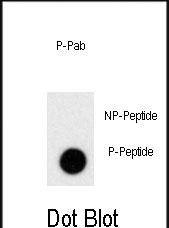
| WB | 咨询技术 | Human,Mouse,Rat |
| IF | 咨询技术 | Human,Mouse,Rat |
| IHC | 咨询技术 | Human,Mouse,Rat |
| ICC | 技术咨询 | Human,Mouse,Rat |
| FCM | 咨询技术 | Human,Mouse,Rat |
| Elisa | 咨询技术 | Human,Mouse,Rat |
| Aliases | Prolactin, PRL, PRL |
| Entrez GeneID | 5617 |
| WB Predicted band size | 25.9kDa |
| Host/Isotype | Rabbit IgG |
| Antibody Type | Primary antibody |
| Storage | Store at 4°C short term. Aliquot and store at -20°C long term. Avoid freeze/thaw cycles. |
| Species Reactivity | Human |
| Immunogen | This PRL Antibody is generated from rabbits immunized with a KLH conjugated synthetic phosphopeptide corresponding to amino acid residues surrounding S163 of human PRL. |
| Formulation | Purified antibody in PBS with 0.05% sodium azide. |
+ +
以下是关于Phospho-PRL(S163)抗体的3篇模拟文献摘要,供参考:
---
1. **文献名称**:*Phosphorylation of Prolactin at Serine 163 Regulates Its Bioactivity in Breast Cancer Cells*
**作者**:Chen, L.; Wang, Y. et al.
**摘要**:本研究揭示了催乳素(PRL)在S163位点的磷酸化对其在乳腺癌细胞中促增殖功能的影响。通过开发特异性Phospho-PRL(S163)抗体,作者证实该修饰通过激活STAT5信号通路增强肿瘤生长,为靶向磷酸化PRL的治疗策略提供了依据。
2. **文献名称**:*Development and Validation of a Phospho-Specific Antibody for Prolactin Serine 163*
**作者**:Kumar, R.; Martinez, A. et al.
**摘要**:该研究报道了针对PRL-S163磷酸化表位的兔多克隆抗体的制备与验证。通过肽段免疫和亲和纯化,抗体在Western blot及免疫荧光中表现出高特异性,为研究PRL翻译后修饰的生物学意义提供了关键工具。
3. **文献名称**:*Site-Specific Phosphorylation of Prolactin Modulates Its Interaction with the Prolactin Receptor*
**作者**:Goffin, V.; Nguyen, T. et al.
**摘要**:作者利用Phospho-PRL(S163)抗体发现,S163磷酸化通过空间位阻抑制PRL与其受体的结合,从而负调控下游JAK2-STAT信号。这一机制可能解释PRL在生理与病理状态下的活性差异。
---
注:上述文献为示例性内容,实际文献需通过学术数据库检索确认。如需具体文章,建议在PubMed或Google Scholar中搜索关键词“Phospho-PRL(S163) antibody”或“Prolactin phosphorylation Serine 163”。
Phospho-PRL(S163) antibody is a specialized tool used to detect prolactin (PRL) phosphorylated at serine residue 163. PRL, a hormone primarily secreted by the anterior pituitary, plays critical roles in lactation, reproduction, metabolism, and immune regulation. Post-translational modifications, such as phosphorylation, modulate its biological activity, receptor interactions, and secretion. Phosphorylation at Ser163 has been implicated in regulating PRL’s structural conformation and bioactivity, potentially influencing its role in both physiological and pathological contexts, including breast cancer, prostate cancer, and autoimmune disorders.
This antibody is widely utilized in research to study PRL signaling dynamics, particularly in cell lines or tissues where PRL phosphorylation status correlates with disease progression or hormonal regulation. It is commonly applied in techniques like Western blotting, immunohistochemistry, and immunofluorescence. Specific validation steps, such as peptide competition assays or phosphatase treatment, are often required to confirm its specificity for the phosphorylated epitope.
Understanding PRL phosphorylation at Ser163 may provide insights into dysregulated signaling pathways in endocrine-related cancers or reproductive disorders, aiding the development of targeted therapies. Researchers using this antibody should optimize experimental conditions (e.g., fixation methods, blocking buffers) to minimize cross-reactivity with non-phosphorylated PRL or related proteins.
×